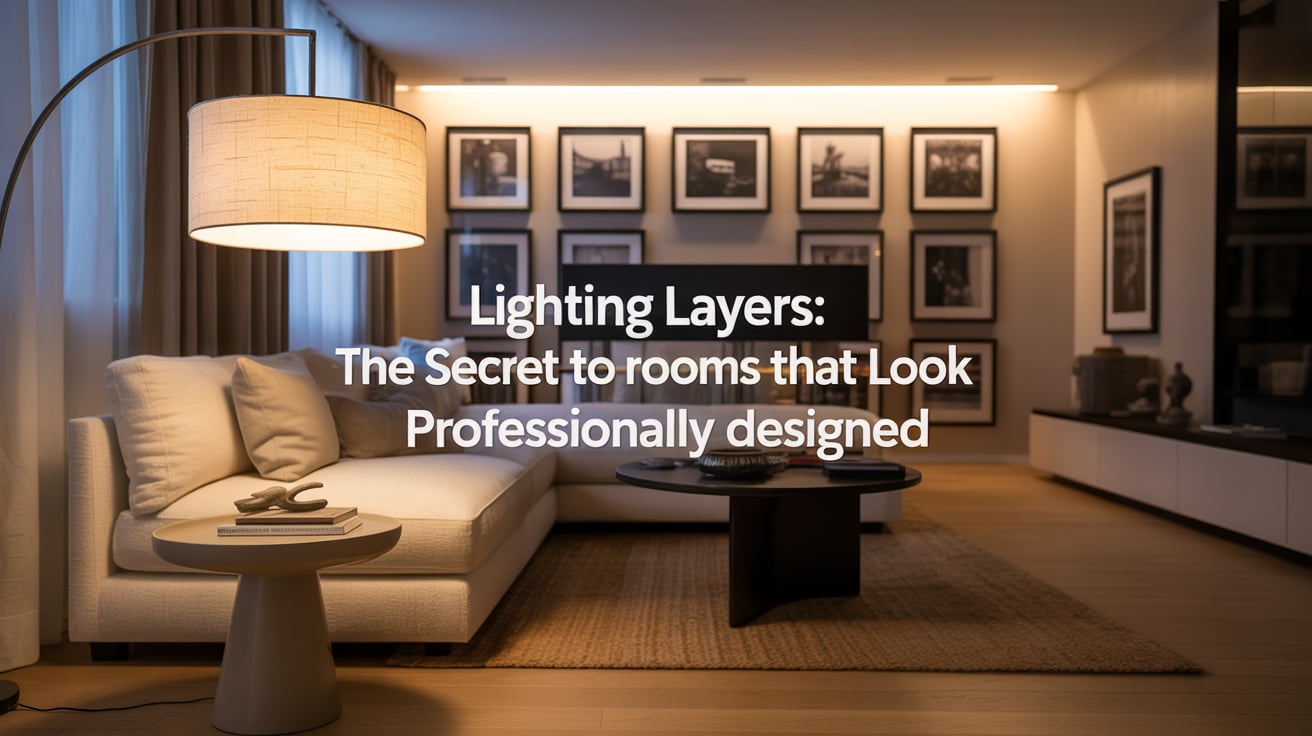
Master the three-layer lighting formula that transforms ordinary rooms into stunning spaces. Professional lighting design isn't about having the most expensive fixtures—it's about creating the right balance of light for every moment and mood.
Walk into any professionally designed room and you'll immediately sense something special, even if you can't pinpoint exactly what it is. The secret isn't expensive furniture or perfect paint colors—it's sophisticated lighting that creates depth, mood, and functionality through carefully planned layers. While most homeowners rely on a single overhead fixture per room, professional designers use a minimum of three distinct lighting layers that work together to create spaces that feel both beautiful and livable. Once you understand this layered approach, you'll never look at lighting the same way again.
Layer 1: Ambient Lighting (The Foundation) Ambient lighting provides overall illumination and sets the room's baseline brightness. Think of it as the canvas that everything else is painted on top of. Without proper ambient lighting, even the most beautiful accent lights will feel harsh and disconnected.
Layer 2: Task Lighting (The Functional) Task lighting illuminates specific activities—reading, cooking, applying makeup, or working at a desk. This layer ensures you can actually use your spaces effectively while reducing eye strain and improving safety.
Layer 3: Accent Lighting (The Drama) Accent lighting creates visual interest, highlights architectural features, and adds personality to your space. This is where the magic happens—accent lighting transforms functional rooms into atmospheric experiences.
The Professional Secret: These layers should never compete with each other. Instead, they should blend seamlessly, with each layer serving its purpose while contributing to the overall lighting symphony.
Color Temperature Matters: Light color is measured in Kelvin (K). Warm light (2700K-3000K) creates cozy, intimate atmospheres perfect for living spaces and bedrooms. Cool light (4000K-5000K) enhances focus and is ideal for task areas like kitchens and offices. Neutral light (3500K) works well in transitional spaces.
The Dimming Advantage: Dimmable fixtures allow you to adjust lighting throughout the day and for different activities. A dining room needs bright light for board games but soft light for romantic dinners. Dimming controls let one fixture serve multiple purposes.
CRI (Color Rendering Index): This measures how accurately colors appear under artificial light. Look for bulbs with CRI ratings of 90 or higher in areas where color accuracy matters—kitchens, bathrooms, and dressing areas.
Beam Angles: Wide beam angles (40+ degrees) work for general lighting, while narrow beams (15-25 degrees) create focused accent lighting. Understanding beam angles helps you choose the right fixtures for each lighting layer.
Living Room: The Social Stage
Ambient Layer Strategy:
Task Layer Applications:
Accent Layer Drama:
Professional Tip: Use odd numbers of light sources (3, 5, 7) rather than even numbers. This creates more visually interesting and natural-feeling lighting arrangements.
Ambient Foundation:
Task Lighting Essentials:
Accent Opportunities:
Kitchen Lighting Formula: Plan for 50 lumens per square foot for ambient lighting, plus dedicated task lighting for all work surfaces.
Ambient Serenity:
Task Lighting Solutions:
Accent Elements:
Sleep-Friendly Strategy: Use warm light (2700K) in bedrooms and consider fixtures with red or amber night modes that don't disrupt circadian rhythms.
Ambient Elegance:
Task Considerations:
Accent Drama:
Dining Room Rule: The bottom of your dining room chandelier should hang 30-36 inches above the table surface, and the fixture should be about 1/3 the width of your table.
Ambient Efficiency:
Task Lighting Precision:
Accent Motivation:
Office Lighting Standards: Aim for 500-1000 lux at desk surface level, with surrounding areas at 200-500 lux to prevent harsh contrast.
Ambient Clarity:
Task Lighting Accuracy:
Accent Sophistication:
Bathroom Safety: All bathroom fixtures must be rated for their specific location (dry, damp, or wet) and meet local electrical codes.
Dimmer Controls: Install dimmers on all your lighting layers to control the intensity and create different moods throughout the day.
Color Temperature: Use warm white (2700K-3000K) for living areas and bedrooms, and cool white (3500K-4000K) for kitchens and home offices.
Lighting Zones: Create different lighting zones in larger rooms to accommodate various activities and times of day.
Smart Lighting: Consider smart lighting systems that allow you to control all layers from your phone and create preset scenes for different activities.